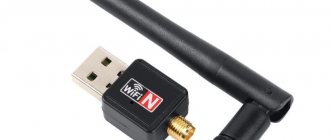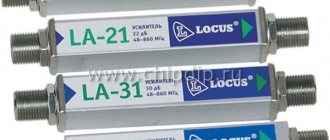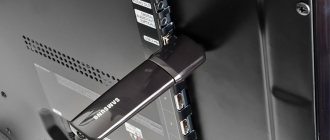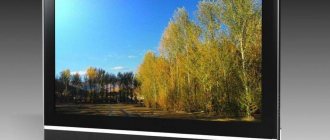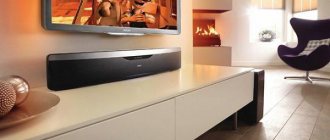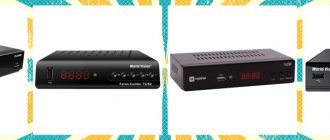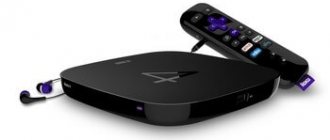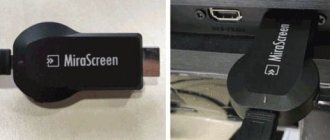Televisions have been popular throughout the 20th century since their creation. For a long time, television has improved, improved and only gotten better - in terms of technology. Now you can easily watch any movie, listen to music or view photos from a black box.
Although now they look more like black squares hanging on the wall. Oh, Malevich! You predicted the future in your time. And now everyone has your prediction. And we look at the black square and see all the charms and beauty of this world.
Modern TVs are equipped with a module that can receive a Wi-Fi signal. At the same time, you can connect it to your home router and receive a TV signal from the Internet or from a computer. It is also very convenient to broadcast from a laptop and watch movies in widescreen HD quality with the whole family.
What to do if this adapter is not available? The fact is that not all TV manufacturers install it inside. In this case, a Wi-FI adapter will help to connect the TV to a wireless network.
Advantages and properties
- Connect to a wireless network without using twisted pair or other wires.
- Synchronization with laptops, computers, phones and other devices for sending videos, movies, photos, music to the TV screen.
- Display your PC desktop on your TV screen.
- Watch movies in wider resolution. Agree, watching a movie from a laptop with the whole family is not very convenient.
- Receiving a digital TV signal from the provider via the router. That is, the Internet cable that is connected to the router will supply not only the Internet, but also TV.
- Control your device from your phone or tablet. This feature is not available on all models.
Questions about drivers and software
Wi-Fi USB adapters need to be configured correctly. The initial stage here is always the installation of the necessary drivers for the specific operation of the device. When the adapter is connected to the computer, the system selects a driver.
There is a possibility that it does not fully correspond to the purchased device. Then the adapter will not work correctly, although the purchased adapter usually includes a disk with a set of optimal drivers and licensed software.
You need to install all programs and drivers from this disk.
If the user has a laptop without a CD-ROM, but has a network connection, you just need to visit the official resource of the device manufacturer and download the appropriate programs.
TOP rating of the best adapters for connection
To select this rating, I specifically looked at the characteristics of the models first. I correlated two main parameters: price and quality. And then I looked at the reviews to see how this or that model behaves in real life. You can view the review and make a comparison yourself based on your criteria.
Wi-Fi TV receiver Dongle M3
Huge support for television and digital video formats. There is built-in RAM and the ability to connect an external SD drive. Does not work with 5 GHz frequency.
| CPU | ARM Cortex A7 Rockchip RK3036G 1.2 GHz |
| operating system | Linux 3.0.8 |
| External antenna | 2.4GHz |
| Picture size | 480/720/1080P |
| Formats | AVI, DIVX, MKV, TS, DAT, MPG, (MPEG1,2,4,) MP4 |
TOSHIBA WLM-20U2
A good budget option for home. Reliable model without interruption with a high-quality antenna. Will be able to work continuously and stably in a 3-7 room apartment.
| Price | 1620 |
| Supported Standards | Wi-Fi 1 (802.11b) Wi-Fi 3 (802.11g) Wi-Fi 4 (802.11n) |
| Frequency | 2.4 – 5 GHz |
| Interface | USB 2.0 |
| Antenna | 1 internal |
Samsung WIS12ABGNX/NWT
Specialized device for Samsung TVs. DLNA allows you to connect mobile devices, phones, photo and video cameras. Has version 1.5.
| Standards | 802.11 (b, n, g, a) |
| TV support | Samsung D5000, D8000, C550, D550, E 490 |
| Connection | DLNA |
| average cost | 1400 |
USB WiFi adapter UWA-BR100
Designed for Sony equipment. Well suited for almost all TVs of this company. Works stably in a small apartment. A larger home may require a stronger transmitter or installation close to the receiver. The only negative is the high price.
| Data Standards | IEEE 802.11a, 802.11b, 802.11g, 8 |
| Compatibility | for Sony AV equipment |
| Frequency | 2.4 – 5 GHz |
| Encryption | WPA, WPA2, WEP |
| Price | 7000 |
LG AN-WF500
This is a full-fledged module with an external adapter to improve signal reception. It also has a built-in Bluetooth transmitter for connecting headphones or other wireless headsets. A small drawback is that it is connected via a wire, and the model itself must stand or be fixed next to the TV.
| Model support | LG LB5800, LB6100, LB6190, PB6600 |
| Network protocols | 802.11n, 802.11g, 802.11b, 802.11a |
| Data transfer | WiFi |
| Built-in Bluetooth | Version 3.0 |
| Price | 3200 |
Stream TV DIB-200 from D-Link
Budget model with micro-USB and HDMI port for connection. You can connect from your phone or tablet. Works with operating systems based on Android and iOS.
| Connecting mobile devices | Android 4.2 and above, iOS 5.0 and above |
| Video format | 1080p |
| Interface | HDMI, micro USB |
| Price | 800 |
Philips PTA01/0
To output digital media files for older Philips models without a Wi-Fi module. Excellent data transmission quality without interference or interruptions.
| Device Compatibility | 32PFL7605, 32PFL7655, 32PFL7665, 32PFL7675, 32PFL7685, 32PFL7695, 32PFL8605, 37PFL7605, 37PFL7675, 37PFL8605, 40PFL7605, 40PFL8605, 42P FL7655, 42PFL7665, 42PFL7675, 42PFL7685, 42PFL7695, 42PFL8605, 46PFL7605, 46PFL7655, 46PFL7665, 46PFL7695, 46PFL8605, 46PFL8685 52PFL8605, _PFL58x6 (Eu), _PFL6xx6 (Eu), _PFL74x6 (Eu), _PFL7606 (Eu), _PFL7656 (Eu), _PFL7676 (Eu), _PFL7696 (Eu), _PFL58x6 (LatAm), _PFL6xx6 (Lat Am), _PFL7xx6 (Lat Am) , _PFL8xx6, (Lat Am), _PFL7xx6 (Asia), _PFL35x7 (Eu), _PFL4xx7 (Eu) |
| Frequency | 2.4 GHz |
| Encryption | WPA/ WPA2/ WEP |
| Price | 2230 |
| Connection | USB 2.0 |
Connection methods
Currently there are two main methods:
- Wired.
- Wireless.
The first is characterized by greater stability, but the entire apartment is cluttered with wires. This violates the aesthetics of the interior and causes serious discomfort. Other disadvantages of a wired connection are:
- Using a network cable for a TV makes it impossible to access the network on other devices.
- Most providers are upgrading their standards. Often, to configure a connection, you need to manually specify data.
These shortcomings can be compensated for by using a router. But many users also do not want to tinker with it and its settings. Therefore, the second method is generally preferred.
There are models with an integrated adapter and modifications that provide for its connection. Current receivers also have a network connector. This provides connectivity via both methods.
But if your TV does not have a wifi adapter and the ability to connect it, you will only have to use the first method.
How to choose?
I’ll immediately note one very important detail; I advise you to take a module from the same manufacturer as your TV. Then there will be no connection problems. No matter how some models claim that they supposedly fit all models, disconnects or interruptions may occur during viewing.
Such devices cost a little more, but believe me, the picture quality will be better. Once, a friend of mine bought a cheap model. The result is that the picture was interrupted and the flash drive was constantly heating up due to the flow of data.
In no case should you confuse an external Wi-Fi adapter for a laptop or computer and a module for a TV. Yes, they use the same protocols and standards, but the problem lies in the TV's firmware. The fact is that if you connect the adapter from a PC, most likely nothing will work, and there will be no signal. Perhaps in the future the firmware on TV devices will be made more cross-platform.
There are three types of connection:
- PCMCIA
- HDMI
- USB
PCMCIA is an older type of digital connection. Nowadays, Wi-Fi modules with USB and HDMI interfaces are more often sold. For devices from LG, Philips, Samsung, Panasonic, Toshiba, Sony, you should take a proprietary Wi-Fi unit. For others, cross-platform modules may be suitable - for example from D-Link.
Connecting and setting up a Wi-Fi adapter to your TV
In general, the process of connecting and further setting up a Wi-Fi module is divided into the following stages:
- Plug the device into the USB port on the TV. Most models can be connected via HDMI. In this case, the data transfer speed will be slightly higher.
- Go to the TV menu by pressing the corresponding button on the remote control.
- From the list of options that open, select “Network and Internet”. This line may be called differently depending on the TV model.
- An additional window will open, where you need to tap on the line “Network settings”.
- Next, the user will be presented with several types of networks. Here you need to select “Wireless mode” and press “Ok” on the remote control.
- A window will open with the names of the networks.
- Click on the name of your access point.
- Enter the password for the Wi-Fi router in the appropriate field.
- The device synchronization process will begin, after which you need to click “OK”. The connection will be established.
Connecting a Wi-Fi adapter to a TV
Thus, a Wi-Fi adapter for TV allows you to watch movies and TV series in high definition. This is a great option for those who are used to using the Internet on a big screen. The information presented above allows you to understand which TV adapter for Wi-Fi is better.
Tuner standards and signal strength
As you may have noticed, most models that work with a Wi-Fi network have so-called data transfer standards. This is a very important indicator for both the receiver (in this case, our module) and the sender (router or router).
The maximum speed and range depend on the supported standards. The receiver uses these standards more often.
| Standard | Radius | Frequency | Data transfer rate |
| 802.11a | up to 30 meters | 5 GHz | 54 Mbit/s |
| 802.11g | up to 50 meters | 2.4 GHz | 54 Mbit/s |
| 802.11n | up to 100 meters | 2.4 or 5 GHz | theoretically up to 480 Mbit/s |
It must be borne in mind that these throughput and footage indicators are maximum under ideal conditions. That is, in life, walls, radio waves, telephone and electromagnetic waves usually reduce both the range and speed by an order of magnitude.
Also consider the operating frequency of the receiver and transmitter. If they operate at different frequencies, the receiver will not be able to pick up the signal. According to standard settings, routers have a frequency of 2.4 GHz, which increases the range.
But cunning system administrators can set the frequency to 5 GHz, which slightly increases the security of the network. This is usually done to connect Wi-Fi cameras. Because of this unpopular standard, attackers will not be able to connect to both the router and the Wi-Fi camera. So be sure to look at the operating frequency of the module.
It is imperative to take into account the number of obstacles from the router to the TV. The best option is 5-10 meters with 1-2 walls. Walls should not be more than 20 cm wide. If there are many more obstacles in the way, a microwave oven, a radiotelephone or other sources of interference, then the signal will be weaker and the radius will be smaller.
Because of which the speed will drop. Packets that will be sent to TV will be lost in the chaos of waves of different frequencies, and the video or film will slow down.
All current models have WPA and WPA2 encryption standards. WPA is needed to support older routers, but this technology is not very reliable and the network can be hacked. WPA2 is a modern signal encryption technology and is almost impossible to crack.
Let's summarize and highlight the main aspects for choosing the right device:
- TV brand – it’s worth taking branded adapters.
- If the TV does not have its own line of modules, it is worth taking a cross-platform one with compatibility between different TV devices.
- Supports 2.4-5 GHz frequency and 802.11 standard – class a, g and n.
- With WPA2 or WPA encryption.
Popular manufacturers
Wi-Fi adapters are produced today by many companies, including leading electronics manufacturers. The most famous of them:
- Xiaomi. A Chinese brand known for its inexpensive and high-quality products. It produces many models of inexpensive Wi-Fi adapters in various colors and small sizes. Most often with USB connectors.
- Asus. Taiwanese brand. The company's Wi-Fi adapters usually work with the most popular interfaces.
- LG. South Korean brand. Wireless adapters support all standards and transmit information at speeds comparable to cable transmission. LG produces adapters not only for routers, but also for smartphones.
- Samsung. This South Korean brand offers the widest range of Wi-Fi adapters. All devices are characterized by uninterrupted operation and high power levels.
- Tenda . The range of wireless adapters from the Chinese brand is distinguished by a variety of shapes. Most of the products have a minimalistic design and black and white coloring. Most often they have a connection type via a USB port.
How to install and configure
- We plug the Wi-Fi module into the TV into any of the available connectors.
- Next, on the TV, from the remote control, go to settings or options.
- Go to the “Networks” section. Depending on the type of firmware, the name of the configuration section may be different (Wireless networks, wireless connection), the main meaning is here.
- Now we connect to the wireless network. Select your network.
- Enter the access password and connect.
WPS connection
- We go to the router and look for the WPS quick access button. It is usually located on the back panel. For Zyxel Keenetic routers, the button is located on the front of the device - it has a wave or key icon. Just press the button.
- To do this, set the setting to WPS in the TV settings. You will be asked to enter your PIN or password.
- We go back to the router and click on the same WPS button for access.
Criterias of choice
Wi-Fi adapter for Samsung Smart TV
When choosing a Wi-Fi module for TV, you need to pay attention to a large number of factors that affect the quality of the device. Below we will present several important criteria.
Wi-Fi transmitter power
The quality and stability of the signal supplied from the router depends on this parameter. In order not to constantly reboot the router, it is important to choose an adapter whose power is at least 20 dBm.
Powerful Wi-Fi adapter for TV
Important! When choosing a transmitter, you need to take into account the power of the router itself. This indicator for these devices should be approximately the same, otherwise the signal will regularly disappear due to communication asymmetry.
In some situations, for a high-quality wireless network signal, you will need to change the router, since it is the main device on which the stability of the Internet depends.
Operating frequency
For many TV adapters, this indicator ranges from 2.4 to 5 GHz. Intuitively, the higher the operating frequency, the more stable and better the signal. At the same time, the data transfer speed also increases.
The consistency of this parameter for both the Wi-Fi module and the router is also important. This means that the operating frequencies of these devices must be in the same range.
Radius of action
This criterion depends on the operating conditions of the equipment. When choosing a Wi-Fi adapter for your TV, you need to consider its location in relation to the router. As a general rule, the range should be greater in open spaces than in indoor spaces.
Information about the technical characteristics of the Wi-Fi module is indicated on its packaging. The range of action, which is measured in meters, is also presented there. It is preferable to choose devices that have this parameter at least 15 m, even if the router will be located in close proximity to the adapter.
Note! Signal quality largely depends on obstacles. For example, walls or partitions can interfere with device synchronization.
Wi-Fi adapter supporting 802.11n standard
Signal standard
This is an important parameter that affects the data transfer speed. The router that will distribute the Internet must be of the same standard as the Wi-Fi module for the TV, otherwise problems may arise with synchronizing the equipment.
There are several network standards:
- 802.11n. The standard was developed for industrial networks and is characterized by high information transfer speed and stable signal;
- 802.11g. The actual information exchange speed of this standard is 60 MB/s, which is three times lower than that discussed in the previous paragraph;
- 802.11a. Often used for home networks, as it has average speed.
Compatible with TV model
As a rule, the manufacturer of the Wi-Fi transmitter indicates on its packaging information about compatibility with other devices. You should read this information first to avoid connection problems.
However, the compatibility of the purchased module with TV can be configured by flashing it.
Note! If the Wi-Fi adapter and the TV are of the same brand, then the likelihood of their compatibility is high.
Wi-Fi module for TV from Tp-Link
Encryption algorithm
To prevent unauthorized access attempts, you need to come up with a strong password for your wireless network. The setup process on different router models looks similar:
- Connect the router to the computer via the LAN port.
- After completing the previous step, information about the connected device should be displayed on the monitor screen.
- Go to the “My Computer” panel and click on the “Network” tab.
- In the list presented, you need to find the name of your router and right-click on it.
- In the window that opens, tap on the line “Go to the device’s web page.”
- Enter your login details. Usually the login and password are indicated on the back of the router.
- A window with modem settings will open. Here you need to click on the “Network” or “Internet” tab.
- Go to the “Wireless Access” section, then to “Protection”.
- A window will open where you will need to specify the password and name of the access point.
The setup process is similar for different router models.
Important! To ensure secure encryption, it is recommended to specify a password of at least eight characters, preferably using letters.
After completing the above procedure, you can go to the TV settings and connect to this router by entering the previously specified password.
Router setup window on computer
Doesn't connect - problem solution
Let's first look at what frequency our router operates at; perhaps the wireless network settings were previously set to 5 GHz. The fact is that the module usually operates according to the standard at a frequency of 2.4, and if the router settings are set to 5 GHz, there will be no connection.
- Open the browser and enter 192.168.1.1 or 192.168.0.1 in the address bar.
- We register the login and password that was set earlier.
- In the menu we look for “Wireless network” , “ Wi- Fi” or “SSID”.
- Set the frequency to 2.4 GHz. Also make sure all 802.11 class a, g and n standards are installed.
If this does not help, then you need to register the network settings on the TV. We go into the network settings and manually register the IP, mask and DNS. You can use the Google config as DNS:
- Main: 8.8.8.8
- Alternative: 8.8.4.4
What is it for?
The Wi-Fi adapter is designed for wirelessly receiving movies, audio and photos from the Internet, computer, smartphone, tablet, etc. to play this media on a big screen.
Using a Wi-Fi adapter, you can quickly synchronize your TV and another device. This makes it possible to set up a local network between a PC and a TV, without the use of wires and over a long distance.
You can simultaneously work on your computer and stream media content to your TV, or use it as a second screen without using a router.
How to boost or improve the signal
Sometimes there is a connection, but there may be problems with video interruption when the picture starts to lag. This means that the speed has dropped and packets are being lost. There are several things you can do:
- Try to place the router as close to the TV as possible.
- There should not be any significant interference on the way to the signal in the form of telephones and microwaves.
- Go to your router settings. Then to the wireless network. Make sure that the desired option is in the “country” subsection. This is necessary for the device to automatically detect the communication channels used. This way, Wi-Fi will not conflict with radio and telephone waves according to the standard in your country. If there is no country setting, then set the channel to mode: 1, 3 or 5.
- Turn the antennas towards the TV and tilt them at an angle of 45 degrees.
Advantages of HDMI over USB adapter
HDMI stands for High Definition Multimedia Interface. This port transmits a high-resolution digital signal. If you have a TV with a very clear screen resolution, then for accurate and better display of audio, video and photo content, it is better to choose an adapter with HDMI output. It differs from USB in that it has greater speed and accuracy of data transfer, so even a movie that takes up a lot of space will be displayed very clearly on the TV screen.
When choosing a Wi-Fi adapter for your TV, you need to consider:
- its brand;
- compatibility with different adapters;
- router parameters;
- the required speed, power and frequency of the adapter;
- image clarity (adapter output);
- price and availability of analogues.
SMART TV set-top box
Smart TV allows you not only to receive a signal from a PC, laptop or phone, but also to organize Internet access directly from the TV. For film buffs, this is just a godsend. You can go to any website from a TV running a set-top box and watch TV series, movies, Youtube, Twitch, or just read articles and browse pages.
Expensive modern models have this function, but they are also expensive. So you can just buy a cheap TV with a high-quality picture and an additional set-top box. The set-top box also has a Wi-Fi receiver that allows you to connect to a local network. Therefore, the connection can be made in two ways: via wire and via Wi-Fi.
Features of Smart TV set-top boxes
- Access the Internet using the built-in browser interface.
- Search is carried out using the numeric keypad. Not very convenient, but practical.
- Supports all existing codecs and Flash player.
- Some models have a card reader system that supports well-known card formats. So you can easily connect a card from a photo or video camera and watch photos from your vacation.
- The built-in memory allows you to record football matches, movies, cartoons even when the device is turned off.
- Can act as a digital set-top box.
- High speed of receiving and processing information.
iconBIT Movie One (PC-0036W)
| operating system | Android 4.4 |
| Memory cards | microSD, microSDHC |
| Built-in memory | 1GB |
| Inputs | USB 2.0, HDMI, 3.5 mm audio/video, LAN (RJ-45) |
| Price | 3845 |
iconBIT Movie Ultra HD 4K (PC-0035W)
| operating system | Android 7.1 |
| Memory cards | microSD, microSDHC |
| Built-in memory | 8GB |
| Inputs | USB 2.0, HDMI, 3.5 mm audio/video, LAN (RJ-45) |
| Price | 7000 |
How to choose?
I'll briefly tell you what you should pay attention to:
- Supports two connection types: Internet cable and Wi-Fi. There are models with only one type of connection, so you need to look at it based on the situation.
- For high-quality images and fast work without brakes, it is better to choose a Quad Core or Dual-core microprocessor. There must be at least 2 cores.
- Supported ports. It's better to use HDMI. For older TVs, you should choose ones with VGA and AV support.
- Availability of additional ports USB, VGA, Optical, Ethernet.
Modern TVs
Modern TV models are more like some modifications of computers. They have processors with powerful performance and solid integrated memory. To complete the set, all you have to do is connect them to the Internet.
Today, TVs with huge functionality are becoming more and more popular. People also connect television with a colossal number of channels, and “Smart TV” is installed. This technology provides access to the network, allows you to install additional utilities and view and listen to various content.
We can say that modern TV is a powerful media complex. You just need to solve the basic question of how to connect such a TV to the network.
Wi-Fi adapter - what is it?
Those who use a smart Smart TV that is not equipped with a Wi-Fi module have no reason to panic. To access the Internet, you can use an adapter that matches your TV brand. The connected device picks up wireless waves no worse than, for example, the built-in Wi-Fi module for LG an WF100 TV.
Review and configuration of the D-Link Dir-320 modem
Note! The appearance of the adapter is a regular flash drive that plugs into a USB connector.
Options for connecting TV to the Web
To gain access to the Global Network, you need to install an additional cable. An Ethernet channel cannot be divided into digital streams and serve more than one device at a time.
Important! Many providers choose a network standard. This option uses fiber optic communication. However, it is not supported by every Smart TV model.
To set everything up, you need to insert the Ethernet cable into the LAN port of the television set. After going to the network connection settings, you need to select the “Wired” type. As soon as the settings are saved, the TV will need to be rebooted.
